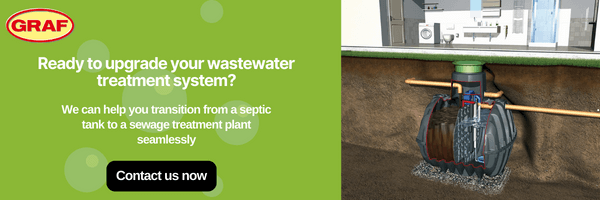Properties that are not connected, or have access to, a local sewer will need a sewage treatment plant in order to safely discharge of household waste. If you currently use a septic tank to discharge waste this will have to be upgraded due to recent changes to the law. In this article we explain the different types of discharge from a treatment plant you can use in your garden.
What is a sewage treatment plant?
Due to the introduction of new General Binding Rules that came into effect on January 1, 2020, septic tanks are no longer allowed to discharge untreated water into a watercourse, as it could be classified as a pollutant which could lead to a fine being issued.
A sewage treatment plant works in a similar way to the larger treatment works used by your local authority, except they are smaller scale and intended for use in domestic environments. Sewage treatment plants introduce bacteria to the cleaning process to break down waste into a cleaner effluent before it is discharged. This is less damaging to local ecology and far kinder to the environment as a whole.
What are the different types of discharge from a treatment plant?
Soakaway
There are a few different types of soakaway, including a soakaway chamber, rubble pit or bore hole soakaway. However, when it comes to sewage treatment plant discharge, a drainage field must be used. This is because it features a network of perforated piping to offer a level of water treatment as it is discharged. Before drainage can be installed, a percolation test has to be carried out to calculate the size of hole required and if the ground is suitable to use for this purpose.
Reed bed
A reed bed is an alternative drainage system that is used to improve water quality before it is discharged into the local environment. It does so by using the natural ability of a reed to transfer oxygen into the soil, which activates microorganisms to eat away any contaminants located in the effluent. The size of the reed bed is determined by the flow volume, with horizontal flow and vertical flow reed beds being two of the most common forms.
Flowing Watercourse
An example of a flowing watercourse would be a river that connects to nearby lake, sea or ocean. Other forms of watercourses include a brook, stream, gayle, rhyne, culvert, leat and beck. A watercourse can only be used if it flows all year round and doesn’t regularly or seasonally dry up (unless in a drought). Discharges also cannot be made into enclosed ponds or lakes.
Local Sewer
You also have the option to discharge via a local sewer. The first thing to do is to check with the local water company to see if one is located nearby. You must then make an application to have a treatment plant connected to the sewer system by the local water company, which will also require payment (this will differ from case-to-case). However, if you own a current treatment system that is served by a public sewer located within 30 metres from your property, you may have to connect to this instead.



